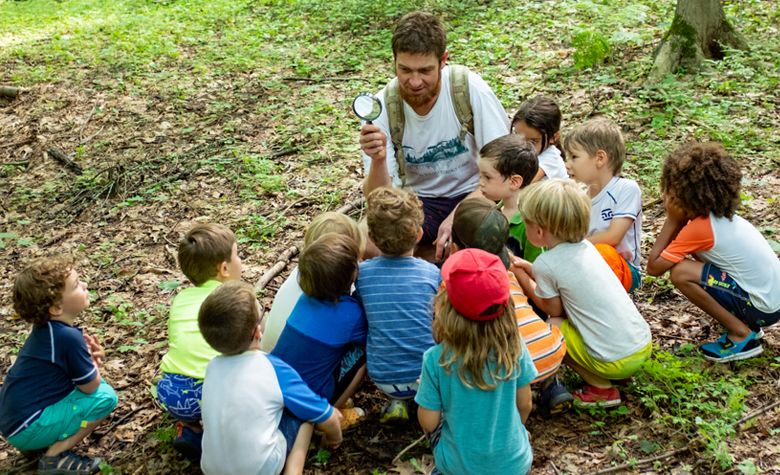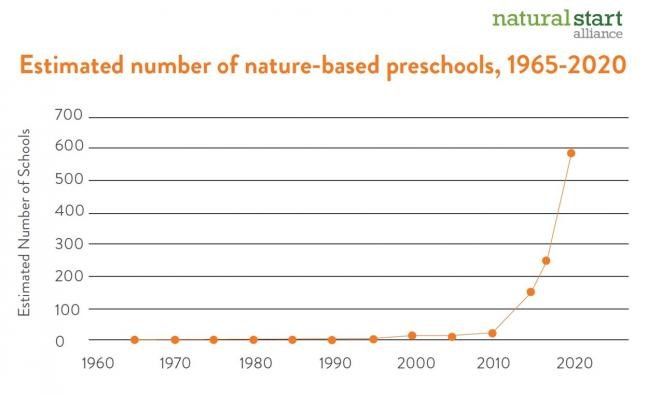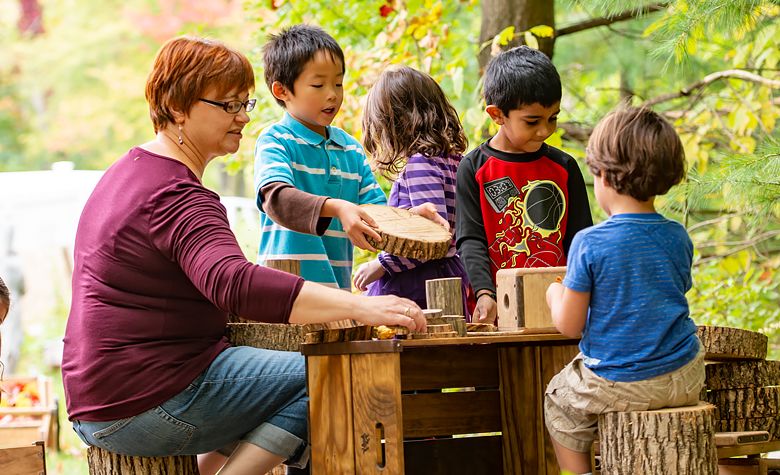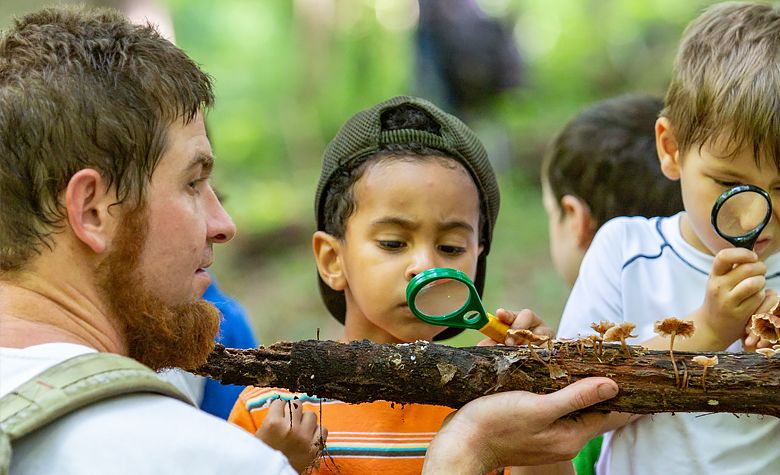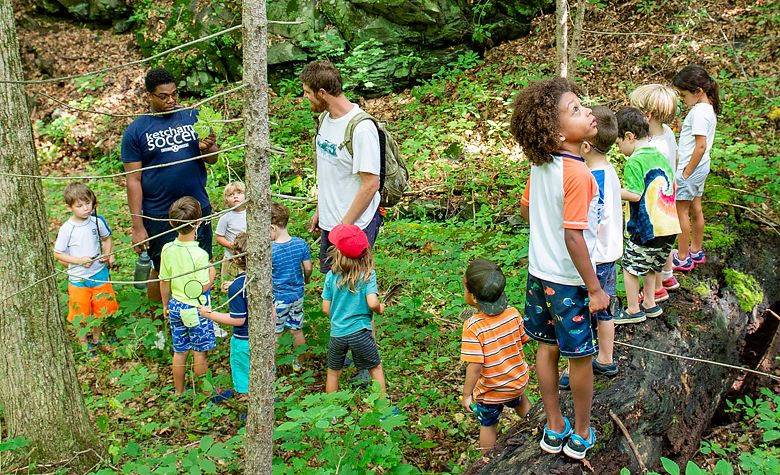What Preschools Need Now is a Dose of Nature
| May 2021Nature has long been an antidote to many of children’s modern ailments. Children are spending far too much time on electronic devices, and nature provides an opportunity to unplug and play with friends. Children are becoming overweight from too much sedentary time indoors, and nature provides endless opportunities to run, climb, build, dig, and more. Children who struggle to sit still and pay attention in school are labeled as problematic, and nature-based schools provide ample space—both literal and figurative—for children to be themselves and put their energy to productive use.
Now, in the age of COVID, nature continues to offer a treatment plan. Early in the pandemic, Dr. Anthony Fauci implored Americans to “get outdoors as much as possible,” and schools listened. All types of schools in all kinds of settings opened the doors and went outside to teach and learn in fresh air as much as possible.
At the Natural Start Alliance, our members are educators and organizations, including preschools, that promote nature-based, outdoor learning for young children. Our members report that demand for outdoor learning is at an all-time high. Now more than ever, an education in the outdoors, with an emphasis on play and personal relationships, feels like just what the doctor ordered.
The question I get consistently as people call and write to us for information about outdoor learning is, “What about after the pandemic? Do you think schools will stay outside?” Here’s why my answer is always an easy yes.
Nature-based, outdoor education was becoming much more popular even before the pandemic.
Although people usually associate outdoor preschools with European countries like Germany (think Waldkindergartens), outdoor education for young children goes back a long way in the United States. Native Americans across North America taught children outdoors, long before the arrival of Europeans, and “nature preschools” have been in the US since the 1960s.
Nature preschools really started taking off in the United States in the past ten years. Natural Start tracks the growth in nature preschools in the United States, and we have seen very rapid growth in recent years. Our 2020 count reveals that programs have grown 25-fold over the past decade, now numbering over 600, with programs in nearly every state.
When nature-based programs open in communities where this approach to education is new, they tend to plant a seed, so to speak. They offer an example and resource in their community of how early childhood education can benefit from a dose of nature. When children who graduate from these programs enter kindergarten well prepared for elementary education, word spreads that these programs are effective. And when educators can see that there are programs near them where children and teachers are spending most—or even all—of the day outdoors, going outside a little bit more feels very doable. And so the model expands.
We’ve invested in outdoor learning.
In order to reopen schools, school districts and government agencies across the US provided funds to schools and communities to make the investments they need to keep children and teachers safe. Some preschools were able to take advantage of this aid, and others made their own investments. In addition to masks and cleaning supplies, schools have purchased materials for outdoor learning, like outdoor storage, mud boots and jackets, tarps and shade structures, fencing, and more.
Many schools have also invested in resources and training. Nature-based education organizations at the state level in particular have stepped up to support their peers who are just stepping out for the first time. They’ve been hosting webinars, mentoring educators, creating resources, and answering all kinds of questions through the year. As a result, many early childhood educators have jumped from outdoor learning 101 to graduate-level study in a matter of months.
These investments and this new knowledge are not going anywhere. Of course both knowledge and materials require maintenance, but we’ve gotten over the first hurdle, which is making the initial investment, and research tells us that these investments will generate real returns.
Teachers and families are seeing the results (and research backs them up).
We know from experience—and research—that outdoor learning for children is effective, and as more schools spend more time outside this year (and, without a vaccine for young children, probably next year too), they’ll have the same experience that countless other programs and families have had, seeing children thrive outside.
We recently checked in with our members—many of whom are new to teaching outdoors—to see how things are going this year. Most indicated that they are spending much more time outside this year, with some moving outdoors entirely unless severe weather makes it unsafe. Many acknowledged that there has been a lot to learn, like figuring out how to keep children comfortable on cold winter days (hint: warm gear, keeping moving, and offering warm snacks were top suggestions when this came up).
But they resoundingly agreed that the benefits far outweigh the challenges, and the future is bright. One program shared that “Moving outside has been an awesome experience, and now our teachers, parents and kids are huge advocates for nature-based early childhood education.” We’ve heard variations on this sentiment over and over again.
And research backs up the idea that outdoor learning is effective. Two recent reviews of research on nature and education are particularly compelling. Both looked at large numbers of studies to understand the connections between nature and learning. In a 2020 review, researchers from Stanford University and Virginia Tech found that the play-based, nature-rich approaches to education employed by environmental education programs led to positive outcomes in young children’s cognitive and social emotional development. And in a 2019 study, a team of researchers from the University of Minnesota and the University of Illinois at Urbana-Champaign found that outdoor learning is associated with positive shifts in perseverance, problem solving, critical thinking, leadership, teamwork, and resilience. They conclude that “In academic contexts, nature-based instruction outperforms traditional instruction.”
But it’s not just academics that can benefit from nature. Research shows that nature can provide powerful mental health benefits, too. In addition to nature’s well documented ability to reduce stress, the 2019 study also noted that nature-rich classrooms provide calmer, quieter, and safer contexts for learning. It’s not every day that schools encounter interventions that can boost student achievement and promote mental health, all at a relatively low cost. So as we look to the future, schools are more likely to lean into the benefits of nature than to lean away.
When we’re out of the woods, we’ll see you in the woods
Heartbreakingly, the list of ailments for children and families right now is long. It includes all of the challenges we’ve been working on for years, and now also includes the pandemic and the mental health implications that go along with it, from trauma and loss to stress and isolation. We have a lot of work to do, but one thing is clear: nature can help. It can help in our communities, and it can help in our schools. That’s why when people ask me where I think we will go from here, once the crisis eases, I say I don’t think we’re going to go anywhere. I think that schools that have moved outside will stay outside, and inevitably, others will follow. That’s what was happening before the pandemic, and there are many reasons to expect the trend will accelerate. This is a prescription for life.

